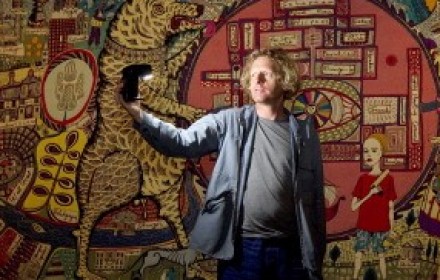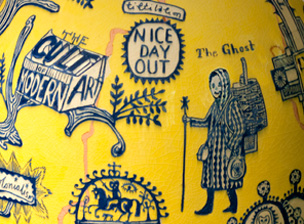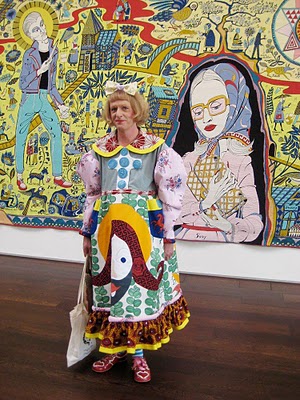End of year “best of” lists abound, so I will keep it short and offer just one very favorite moment of 2011: Grayson Perry’s exhibition at the British Museum in London which I visited this October. Sandwiched between a glorious wedding in Stoke Newington Church and dinner with two much-missed girlfriends, I have to admit I was more susceptible than usual to persuasion as I was a) more than three miles away from school, and b) therefore really happy to be somewhere else than the library. I was an easy customer, but this is beside the point. The show was a gem.
Since he won the Turner Prize in 2003, Perry has cut a controversial figure, addressing transvestism (his female alter-ego Claire), outsider and naïve art (his pottery), the figure of the artist (Perry’s personal history provided the score for this exhibition), and the role of textile, craft, and collaboration, often working with artisans to complete his work. I could give you the detached, scholarly review of The Tomb of the Unknown Craftsman, but I loved it too much not to effuse. Besides, the whole point for Perry – much to the discomfort of a few of his critics/Brian Sewell – is that the expected academic approach of the British Museum is cast off in favor of the personal pilgrimage of both the artist and the visitor. Perry’s male alter-ego, teddy bear Alan Measles, greets the visitor at the door on a personalized motorbike, heralding the deeply idiosyncratic and pretty darn wonderful selection of one hundred seventy objects chosen from the museum collection, and the thirty or so that Perry made especially for the exhibition.
Unlike MoMA’s regular collaboration with figures like Vik Muniz for the Artist’s Choice series, only Eduardo Paolozzi (who rifled through the collection in 1985 for the show Lost Magic Kingdom) and Xhu Bing, who did the same this past summer, have had such free rein with the curatorial direction of the permanent collection of the British Museum. Over two and a half years, Perry talked to staff across many of the museum departments and created a very personal art survey, a jewel box of an exhibition that voyeuristically fulfills most visitors’ secret wish: to roam the British Museum’s basement and choose their favorite objects for display. In a way, that’s just what happens every time anyone crosses the threshold of the British Museum. Any museum. If you’re a tourist, you’ve perhaps come for a special exhibition. However, at your local museum – and this has been Perry’s local since childhood – you gravitate to one or two old favorite objects or areas – the modern wing in the Met. The Scottish Colourists in the Kelvingrove in Glasgow. Or, perhaps my absolute favorite: walking upstairs at the Scottish National Gallery in Edinburgh and looking to the end of the room to see John Singer Sargent’s Lady Agnew of Lochnaw staring back, always with the same sharp beauty.
There’s a huge element of nostalgia in The Tomb of the Unknown Soldier as Perry blends his own works almost indistinguishably with 16th century Iranian watercolors or medieval shrines and Tibetan mandalas. The exhibition title – referencing the various post-WWI tombs of unknown soldiers that stand for an entire generation lost – makes no bones about the museum’s conflicted past, honoring all the unknown and unrecognized craftsmen and creators in the British Museum’s collection through this small selection. The centerpiece of the show is a palimpsestic boat collaged with various globally-sourced forms – Buddha, Ife, Christian, other – and holding a prehistoric stone tool in its heart. The purpose isn’t to ape the British Museum’s objects, or to somehow put his on the same pedestal. Although the show obviously doesn’t hurt the value of Perry’s vases, he’s very careful to name check every single collaborator on his object labels. Instead, the experience offers the artist’s joy in looking and creating as part of a conversation to which the museum visitor is invited to bring just as much enthusiasm and personal response.

Grayson Perry stands in front of his tapestry "Map of Truths and Beliefs" at The Tomb of the Unknown Craftsman exhibition at the British Museum on October 5, 2011.
For all the intellectual hand-wringing these days over the museum declining into one messy entertainment spectacle for the masses, it’s still too often the case that the public – and publicly funded – museum space can feel an inhospitable place for the everyday visitor, especially when it comes to contemporary art. Perry deliberately faces this head on, incorporating (without apology) the museum café and store into the “pilgrimage” of the exhibition. I was unashamedly thrilled at the thought of the apoplectic rage a specially-themed menu and the shop directly at the exhibition’s end (although this is now almost ubiquitous) would have caused many of the museum purists I know. Although these moves are designed to provoke, they also speak to the very real footsteps of most museum visitors. Is it really a dirty secret to go see the museum shop, and to understand this as part or an extension of the same visual work in the exhibition itself? What blew me away with this show is that an artist dealt with this very issue so directly (and sensitively – his wall texts are awesome) without changing the integrity of the objects or the institution.
At the door, Perry’s wall text warns “do not look too hard for meaning here” as a friendly reminder that no specialist knowledge is needed to be able to enjoy the experience. While he’s inserted himself into the museum space through his own work, curatorial choices, and wall text that explains the objects in personal, experiential terms, Perry has also left a deliberately wide gap for the visitor to do the same too. Thus, contrary to his opening sally, by the time you’ve wound your way to the exit, meaning abounds. And it all belongs to you, just gift wrapped by Grayson Perry.






